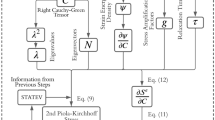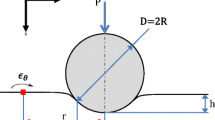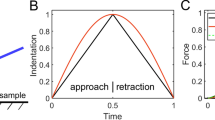Abstract
Motivated by recent progress in viscoelastic indentation analysis, the identification of viscoelastic properties from nanoindentation test data taking the real tip geometry into account is presented in this paper. Based on the elastic solution of the indentation problem, the corresponding viscoelastic solution is obtained by the application of the method of functional equations. This general solution, which accounts for the real geometric properties of the indenter tip, is specialized for the case of a trapezoidal load history, commonly employed in nanoindentation testing. Three deviatoric creep models, the single dash-pot, the Maxwell, and the three-parameter model are considered. The so-obtained expressions allow us to determine viscoelastic model parameters via back calculation from the measured load–penetration history. The presented approach is illustrated by the identification of short-term viscoelastic properties of bitumen. Hereby, the influence of loading rate, maximum load, and temperature on the model parameters is investigated.
Similar content being viewed by others
References
Sneddon IN (1965) The relation between load and penetration in the axisymmetric Boussinesq problem for a punch of arbitrary profile. Int J Eng Sci 3:47–57
Oliver WC, Pharr GM (1992) An improved technique for determining hardness and elastic modulus using load and displacement sensing indentation experiments. J Mater Res 7(6):1564–1583
Cheng L, Xia X, Scriven LE, Gerberich WW (2005) Spherical-tip indentation of viscoelastic material. Mech Mater 37:213–226
Vandamme M, Ulm F-J (2006) Viscoelastic solutions for conical indentation. Int J Solids Struct 43(10):3142–3165
Lee EH, Radok JRM (1960) The contact problem for viscoelastic bodies. J Appl Mech 82:438–444
Abramowitz M, Stegun IA (1972) Handbook of mathematical functions, with formulas, graphs, and mathematical tables. Dover, New York
Lee EH (1955) Stress analysis in visco-elastic bodies. Quarter Appl Math 13:183–190
Findley WN, Lai JS, Onaran K (1989) Creep and relaxation of nonlinear viscoelastic materials. Dover Publications, New York
Partal P (1999) Rheological characterisation of synthetic binders and unmodified bitumens. Fuel 78:1–10
ÖNORM EN 1426 (2000) Bitumen und bitumenhaltige Bindemittel – Bestimmmung der Nadelpenetration [Bitumen and bituminous binders – Determination of needle penetration]. Österreichisches Normungsinstitut, Vienna In German
ÖNORM EN 12593 (2000) Bitumen und bitumenhaltige Bindemittel – Bestimmmung des Brechpunktes nach Fraaß [Bitumen and bituminous binders – Determination of the Fraass breaking point]. Österreichisches Normungsinstitut, Vienna. In German
ÖNORM EN 1427 (2000) Bitumen und bitumenhaltige Bindemittel – Bestimmmung des – Ring- und Kugel-Verfahren [Bitumen and bituminous binders – Determination of softening point - Ring and Ball method]. Österreichisches Normungsinstitut, Vienna. In German
Ulm F-J, Delafargue A, Constantinides G (2005) Experimental microporomechanics. In Ulm F-J, Dormieux L (eds) Applied micromechanics of porous materials (CISM Courses and Lectures No. 480). Vienna, Springer
Press WH, Teukolsky SA, Vetterling WT, Flannery BP (1996) Numerical recipes in Fortran 77: the art of scientific computing, vol 1 of Fortran numerical recipes. Cambridge University Press, Cambridge
Jäger A (2004) Microstructural identification of bitumen by means of atomic force microscopy (AFM), modulated differential scanning calorimetry (MDSC), and reflected light microscopy (RLM). Master’s thesis, Vienna University of Technology, Vienna
Stangl K, Jäger A, Lackner R (2006) Microstructure-based identification of bitumen performance. Int J Road Mater Pavement 7:111–142
Lackner R, Spiegl M, Blab R, Eberhardsteiner J (2005) Is low-temperature creep of asphalt mastic independent of filler shape and mineralogy? Arguments from multiscale analysis. J Mater Civil Eng (ASCE) 17(5):485–491
Author information
Authors and Affiliations
Corresponding author
Rights and permissions
About this article
Cite this article
Jäger, A., Lackner, R. & Eberhardsteiner, J. Identification of viscoelastic properties by means of nanoindentation taking the real tip geometry into account. Meccanica 42, 293–306 (2007). https://doi.org/10.1007/s11012-006-9041-7
Received:
Accepted:
Published:
Issue Date:
DOI: https://doi.org/10.1007/s11012-006-9041-7




